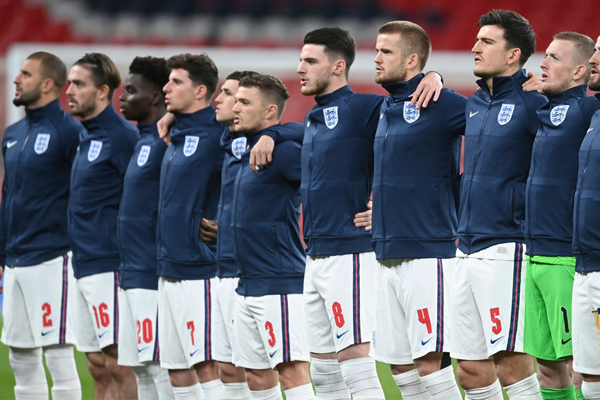By Paul Carr, Professor in Popular Music Analysis, University of South Wales
When the English men’s football team beat Croatia 1-0 in their first match of the 2020 European Championships, fans up and down the country turned to each other and chanted “It’s coming home” and Wembley echoed with it as supporters left the London stadium.
The Three Lions theme, released by comedians David Baddiel and Frank Skinner with the Lightning Seeds before the 1996 European Championships, has become a touchstone of football music. It reached number 1 in the charts that year and was the musical backdrop to the English team’s run up to the semi-finals. It has continued to be sung by hopeful England fans ever since.
The song rose to number one for a second time in 2018 when England got to the semi-finals of the World Cup. But hopes were dashed when they were beaten 2-1 by Croatia. Such is the power of the song for the English that French player Paul Pogba (whose team went on to win the World cup that year) created a spin-off that appeared to be a sarcastic dig at the English team.
So, at a time when England are once again attempting to win their first silverware since 1966, the longevity, popularity and associated meaning of Three Lions raises the question: what makes a good football anthem?
According to folk singer Martin Carthy, the football chant can be considered one of the last embodiments of the oral folk tradition. It gives fans a means through which they can not only express their love (or disdain) for a particular football club; but also, their often-complex relationship with a nation, town, social class or collective identity.

As noted by the historian Dave Russell, many of the football chants we hear on the terraces today have a long history. They’ve been sung by fans since the 19th century–with Sheffield United FC adapting the music hall drinking song Rowdy Dowdy Boys in the 1890s, for example.
It is apparent that in various ways, football’s great anthems can represent our hopes of success, our fear of defeat and our pride in national and local identities.
Football anthems
The football anthem is usually strongly associated with a particular club, nation or event. Like Sheffield United’s early adaptation of a music hall song, more recent football anthems also tap into the culture they operate within.
Usually drawn from popular music, folk, classical or indeed hymns, they sometimes have the power to capture the zeitgeist. For those that are old enough and support England, think how you felt when you heard Three Lions (Football’s Coming Home) in 1996, then consider how it still makes you feel today. The ability of the song to remind us of our hopes, expectations and national identity is tangible.
Arguably the most well-known football club anthem in the UK is Liverpool FC’s use of You’ll Never Walk Alone, which was appropriated by fans after the success of Gerry and Pacemakers’ version of the song in 1963. The lyrics of the song, which has also been used by other football clubs, such as Scotland’s Celtic and Germany’s Borussia Dortmund, features a protagonist who shows resilience “walking through a storm” of adversity. A sentiment that is easy for many supporters to get behind as they show unwavering dedication as their teams lose and unending hope that one day they might win.
The song’s firm association with Liverpool was cemented in the public consciousness in the aftermath of the 1985 Heysel stadium disaster and the 1989 Hillsborough disaster, where it took on more tragic meanings.
A more light-hearted song that has also been taken on by fans is West Ham’s use of the chorus of I’m Forever Blowing Bubbles. A Tin Pan Alley song from the 1920s. As opposed to stoically coping with adversity, the supporters can relate with the more light-hearted approach to loss – “even if we are losing, we will blow bubbles”.
There are many other examples of similar appropriations, such as Newcastle United’s use of the folk song Blaydon Races or Southampton’s use of the hymn When the Saints Come Marching In.
A sense of time, place and identity
It is important to remember however that some anthems don’t come from the terraces, but from record labels, football governing bodies and the clubs themselves.
This phenomenon has a long history and includes songs that glorify players, such as The Belfast Boy – a 1970 tribute to George Best. There are songs created by clubs, like Chelsea’s Blue is the Colour from 1972. Then there are those created for specific events, such as FIFA endorsed songs like Gloryland (1994) by Daryl Hall and Sounds of Blackness, Ricky Martin’s La Copa De La Vida (The Cup of Life, 1998) and this year’s official theme for the European Championships by Martin Garrix, featuring Bono and the Edge from U2.
Football songs and anthems have the potential to give us a greater sense of time and place. They can help us along when singing them, make us feel part of our tribe and like we are part of a team’s success.Football anthems also remind us of the essence of who we are and most importantly, who we were.
Whenever I hear Nessun Dorma, which the BBC used for its coverage of the 1990 World Cup, I am reminded of iconic English footballer Paul Gascoigne’s tears, indeed of my own tears when England missed the opportunity to replicate an occasion that many of us can’t remember but remains in our collective imagination–the 1966 World Cup Victory over West Germany.
As we entered the last 16 of this year’s European Championships, the anthems of nations around Europe had similar resonances with the winners and losers of this year’s competition but only one country brought the cup home. Italy.
This is an updated version of an article originally published on July 18, 2021.
















